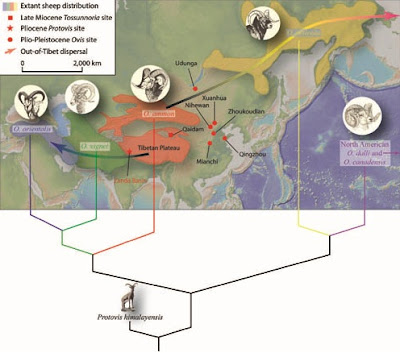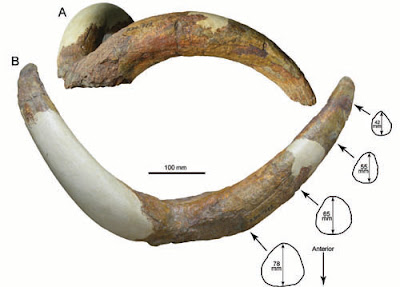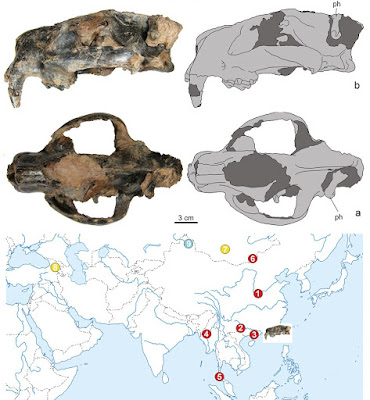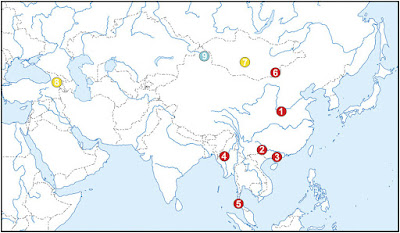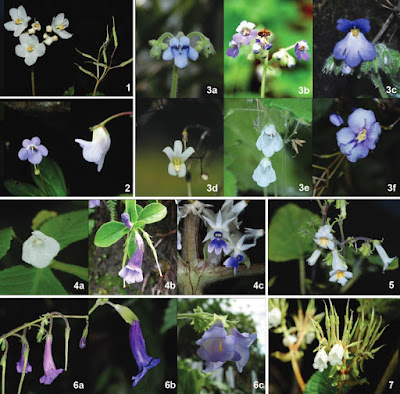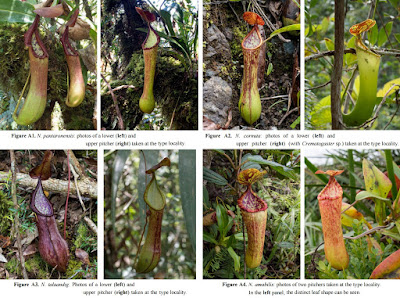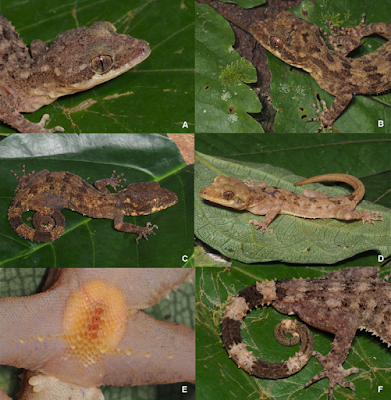[Most Recent Entries] [Calendar View]
Sunday, May 22nd, 2016
| Time | Event | ||||||
| 10:24a | [PaleoMammalogy • 2016] Protovis himalayensis • An Early Sheep from the Pliocene of Tibet, (Bovidae, Caprini), and Origin of Ice Age Mountain Sheep
ABSTRACT Modern wild sheep, Ovis, is widespread in the mountain ranges of the Caucasus through Himalaya, Tibetan Plateau, Tianshan-Altai, eastern Siberia, and the Rocky Mountains in North America. In Eurasia, fossil sheep are known at a few Pleistocene sites in North China, eastern Siberia, and western Europe, but are so far absent from the Tibetan Plateau. We describe an extinct sheep, Protovis himalayensis, gen. et sp. nov., from the Pliocene of the Zanda Basin in western Himalaya. Smaller than the living argali, this new form shares with Ovis posterolaterally arched horncores and partially developed sinuses and possesses several transitional characters leading to Ovis. Protovis likely subsisted on C3 plants, which are the dominant vegetation in the Zanda area during the Pliocene. With the discovery of this new genus and species, we extend the fossil record for the sheep clade into the Pliocene of the Tibetan Plateau, consistent with our previous out-of-Tibet hypothesis. Ancestral sheep in the Pliocene were presumed adapted to high altitude and cold environments, and during the Ice Age, sheep became anatomically modern and dispersed outside of the Tibetan Plateau. Both this new fossil datum and the existing molecular phylogeny suggest that the Tibetan Plateau, possibly including Tianshan-Altai, represents the ancestral home range(s) of mountain sheep and that these basal stocks were the ultimate source of all extant species. Most sheep species survived along their Pleistocene route of dispersal, offering a highly consistent pattern of zoogeography.
Xiaoming Wang, Qiang Li and Gary T. Takeuchi. 2016. Out of Tibet: An Early Sheep from the Pliocene of Tibet, Protovis himalayensis, genus and species nov. (Bovidae, Caprini), and Origin of Ice Age Mountain Sheep. Journal of Vertebrate Paleontology. DOI: 10.1080/02724634.2016.1169190 http://zoobank.org/urn:lsid:zoobank.org:p New Species from the Pliocene of Tibet Reveals Origin of Ice Age Mountain Sheep Modern wild sheep, Ovis, is widespread in the mountain ranges of the Caucasus through Himalaya, Tibetan Plateau, Tianshan-Altai, eastern Siberia, and the Rocky Mountains in North America. In Eurasia, fossil sheep are known by a few isolated records at a few Pleistocene sites in North China, eastern Siberia, and western Europe, but are so far absent from the Tibetan Plateau. In a paper published May 4 in the Journal of Vertebrate Paleontology, paleontologists from the Institute of Vertebrate Paleontology and Paleoanthropology (IVPP) of the Chinese Academy of Sciences, Natural History Museum of Los Angeles County and La Brea Tar Pits and Museum at Los Angeles reported a new genus and species of fossil sheep from the Pliocene of Zanda Basin in Tibet. This finding extends the fossil record for the sheep into the Pliocene of the Tibetan Plateau, suggesting that the Tibetan Plateau, possibly including Tianshan-Altai, represents the ancestral home range(s) of mountain sheep and that these basal stocks were the ultimate source of all extant species, which is consistent with the Out-of-Tibet hypothesis regarding the origins of Ice Age megaherbivores. New fossil materials were collected from IVPP locality ZD0712 in Guanjingtai, Zanda County, Tibetan Autonomous Region in western Himalaya during the 2006 and 2007 field seasons. The holotype specimen (IVPP V18928), forming the main basis of this new species, is a nearly complete male left and right horncores. With a total horncore upper curve length of 443 mm, it is similar in size to some extant species of Ovis. This new extinct sheep, Protovis himalayensis, has a combination of features distinguishable from other species such as Ovis, Pseudois and Tossunnoria. Smaller than the living argali, it shares with Ovis posterolaterally arched horncores and partially developed sinuses and possesses several transitional characters leading to Ovis. ........ New species from the Pliocene of Tibet reveals origin of Ice Age mountain sheep http://phy.so/382171822 via @physorg_com | ||||||
| 10:30a | [PaleoMammalogy • 2016] Maofelis cantonensis • First Nimravid Skull from Asia
Abstract Maofelis cantonensis gen. and sp. nov. is described based on a complete cranium from the middle-upper Eocene Youganwo Formation of Maoming Basin, Guangdong Province, China. The new taxon has characters diagnostic for Nimravidae such as a short cat-like skull, short palate, ventral surface of petrosal dorsal to that of basioccipital, serrations on the distal carina of canine, reduced anterior premolars, and absence of posterior molars (M2-3). It is plesiomorphic nimravid taxon similar to Nimravidae indet. from Quercy (France) in having the glenoid pedicle and mastoid process without ventral projections, a planar basicranium in which the lateral rim is not ventrally buttressed, and P1 present. The upper canine is less flattened than in other Nimravidae. Maofelis cantonensis gen. and sp. nov. exemplifies the earliest stage of development of sabertooth specialization characteristic of Nimravidae. This taxon, together with other middle-late Eocene nimravid records in South Asia, suggests origin and initial diversification of Nimravidae in Asia. We propose that this group dispersed to North America in the late Eocene and to Europe in the early Oligocene. The subsequent Oligocene diversification of Nimravidae took place in North America and Europe, while in Asia this group declined in the Oligocene, likely because of the earlier development of open habitats on that continent. Systematic paleontology Mammalia Linnaeus, 1758 Carnivora Bowdich, 1821 Nimravidae Cope, 1880 Maofelis cantonensis gen. et sp. nov.
Holotype: Collection from the Maoming Basin in the School of Life Sciences, Sun Yat-sen University, Guangzhou, China (SYSU-M) 2, almost complete cranium (skull without mandible), with most of the dentition preserved. Diagnosis: Maofelis is referred to Nimravidae based on the following combination of characters that is diagnostic for this group1,2: cat-like skull with shortened rostrum and mesocranium; palate short, does not extend posterior to the toothrow; walls of the basipharyngeal canal converged posteriorly; ventral surface of petrosal significantly dorsal to that of basioccipital; hypoglossal foramen separated from the posterior lacerate foramen; paraoccipital process moderately large, posteriorly projecting; incisors with reduced lingual cingula; serrations on the distal carina of canine; anterior premolars reduced; P4 without a parastyle; posterior molars (M2–3) absent. Type locality and horizon: The oil shale quarry (21°42′ N, 110°53′ E) located near Maoming City, Maoming Basin, Guangdong Province, China; Youganwo Formation, middle-upper Eocene.
Etymology: The generic name is from Maoming Basin in Guangdong Province where the skull was found, and the felid genus Felis. The species name is from Canton, an older name of Guangzhou City. Alexander Averianov, Ekaterina Obraztsova, Igor Danilov, Pavel Skutschas and Jianhua Jin. 2016. First Nimravid Skull from Asia. Scientific Reports. 6, (25812). DOI: 10.1038/srep25812 | ||||||
| 10:33a | [Botany • 2016] Generic Recircumscription in the Loxocarpinae (Gesneriaceae), As Inferred by Phylogenetic and Morphological Data, with the segregation of Middletonia gen. nov.
Abstract The Loxocarpinae, also known as the “Boea group”, are the subtribe of Gesneriaceae which includes Boea and a number of segregated genera and close relatives. This group currently comprises over 200 species in 15 genera. Here we present the most up-to-date phylogeny, covering all the genera known to belong to the group, based on Bayesian inference and parsimony of the nuclear ITS and the plastid regions trnL-trnF (intron and spacer) and ndhF-trnL UAG(spacers). The results show discrepancies between the current generic delimitation in the subtribe and the clades delineated by the phylogeny. As a result Boea, Damrongia, Paraboea and Streptocarpus are recircumscribed in an attempt to establish a more natural classification and new combinations are made. The new genus Middletonia is described. Keywords: Boea; Damrongia; Paraboea ; Southeast Asia; Streptocarpus Puglisi, Carmen; Yao, Tze Leong; Milne, Richard; Möller, Michael and Middleton, David J. 2016. Generic Recircumscription in the Loxocarpinae (Gesneriaceae), As Inferred by Phylogenetic and Morphological Data. Taxon. 65(2); 277-292. DOI: 10.12705/652.5 | ||||||
| 10:48a | [Botany • 2014] Four New Species of Nepenthes L. (Nepenthaceae) from the Central Mountains of Mindanao, Philippines Abstract Together with the islands of Sumatra (Indonesia) and Borneo (Indonesia, Malaysia), the Philippines are the main center of diversity for carnivorous pitcher plants of the genus, Nepenthes L. Nepenthes are the largest of all carnivorous plants, and the species with the biggest pitchers are capable of trapping and digesting small amphibians and even mammals. The central cordillera of Mindanao Island in the south of the Philippines is mostly covered with old, primary forest and is the largest remaining cohesive, untouched area of wilderness in the Philippines. In a recent field exploration of two areas of the central cordillera, namely Mount Sumagaya and a section of the Pantaron range, four new taxa of Nepenthes were discovered. These four remarkable new species, Nepenthes pantaronensis, N. cornuta, N. talaandig and N. amabilis, are described, illustrated and assessed. Keywords: carnivorous pitcher plants; Nepenthes; biodiversity; Philippines Nepenthes pantaronensis Gieray, Gronem., Wistuba, Marwinski, Micheler, Coritico, V.B. Amoroso, spec. nov. Diagnosis: Differs from N. pulchra Gronem. in having 2 longitudinal nerves (N. pulchra: 3–4), 2 non-fringed or barely fringed wings on the lower pitchers and no wings on the upper pitchers (N. pulchra: fringed wings on the lower pitchers and wings reduced to ribs on the upper pitchers) and in having basal stem leaves with a canaliculate petiole (N. pulchra: broad-winged petiole). Type: Philippines, Mindanao Island, Bukidnon Province, Pantaron mountain range, Mt. Gaka (1,390 m) near Sitio Mahayag (Barangay St. Peter, Malaybalay City, Bukidnon Province, Philippines), 15.08.2012, T. Gronemeyer and F. Coritico, holotype CMUH00008625, Central Mindanao University Herbarium (CMUH), Musuan, Bukidnon, Philippines. Etymology: The specific epithet denotes that N. pantaronensis was discovered in the Pantaron mountain range. Nepenthes cornuta Marwinski, Coritico, Wistuba, Micheler, Gronem., Gieray, V.B.Amoroso, spec. nov. Diagnosis: Differs from N. copelandii Macfarlane in having a narrower lamina, upper pitchers with a distinctive, swollen base and an almost completely cylindrical upper two-thirds (N. copelandii: upper pitchers strongly infundibular with a narrow base and proportionally a much wider opening) and noticeably smaller lower pitchers lacking wings (N. copelandii: wings always present on lower pitchers). Type: Philippines, Mindanao Island, Bukidnon Province, Pantaron mountain range, trail from Sitio Mahayag (Barangay St. Peter, Malaybalay City) to Sitio Balaudo, 15.08.2012, T. Gronemeyer and F. Coritico, holotype CMUH00008547, Central Mindanao University Herbarium (CMUH), Musuan, Bukidnon, Philippines. Etymology: The specific epithet, cornuta (lat. cornu = horn), refers to the plant’s horn-shaped upper pitchers. Nepenthes talaandig Gronem., Coritico, Wistuba, Micheler, Marwinski, Gieray, V.B.Amoroso, spec. nov. Diagnosis: Differs from N. cornuta Marwinski in having bulbous lower pitchers with a flattened, crenellated peristome (N. cornuta: slender lower pitchers; cylindrical towards the pitcher opening; with cylindrical peristome) and having a winged petiole that clasps the stem (N. cornuta: canaliculate petiole). Type: Philippines, Mindanao Island, Bukidnon Province, Pantaron mountain range, trail from Sitio Mahayag (Barangay St. Peter, Malaybalay City) to Sitio Balaudo, 15.08.2012, T. Gronemeyer and F. Coritico, holotype CMUH00008624, Central Mindanao University Herbarium (CMUH), Musuan, Bukidnon, Philippines. Etymology: The specific epithet was chosen to acknowledge the indigenous tribe of the Talaandig. N. talaandig occurs on the ancestral territory of the Talaandig communities of east Bukidnon. Nepenthes amabilis Wistuba, Gronem., Micheler, Marwinski, Gieray, Coritico, V.B.Amoroso, spec. nov. Diagnosis: Differs from N. pantaronensis Gieray in having spathulate-ovate, approximately 10 cm long and 3.5 cm wide leaves with an obtuse apex (N. pantaronensis: up to 28 cm long and narrowly acute apex) and having mostly cylindrical to slightly infundibular upper pitchers that are only 10–15 cm tall and distinctly contracted in the region below the peristome (N. pantaronensis: clearly inflated in the lowest quarter and up to 40 cm tall). Type: Philippines, Mindanao, Mt. Sumagaya, trail from Barangay Mat-I (Municipality of Claveria) to the summit 19.08.2012, T. Gronemeyer and A. Wistuba, holotype CMUH00008635 (male flower), isotype CMUH00008637 (female flower), Central Mindanao University Herbarium (CMUH), Musuan, Bukidnon, Philippines. Etymology: The specific epithet, amabilis (lat. amabilis = lovely), refers to the extraordinary beauty of the compact specimens with very colorful pitchers and mostly striped peristomes that were observed in situ. Infauna At the type locality of N. cornuta, several ant colonies (Crematogaster sp.) were found in dead or dying pitchers of this species. The ants obstruct the pitcher opening with a greyish matter, probably made out of vegetal detritus and dirt. This ‘lid’ has small entry holes along the pitcher walls. The bottom of the pitchers is pierced with one or two round holes, draining them of their digestive fluid. These holes also serve as “emergency exits” for the ants when disturbed. The presence of those insects on some pierced functional pitchers without a nest might suggest that the ants first pierce and drain functional pitchers before colonizing them. A similar colonization has been observed before in other Nepenthes species, e.g., N. macfarlanei Hemsl. in Malaysia [17] and N. maxima Reinw. on the lower slopes of the Maoke Mountains in West Papua (personal observation by the authors).Conclusions Carnivorous pitcher plants are widespread within the Malesian biogeographical region comprising the Malayan peninsula and the islands of Sumatra, Borneo, Sulawesi and the Philippines. Especially in the Philippines, the majority of species are known from centers of diversity and endemism. Several species are restricted to one single mountain top or a mountain ridge.A field research trip to the formerly unexplored central cordillera of Mindanao led to the discovery of four new taxa of carnivorous pitcher plants, namely N. amabilis, N. cornuta, N. pantaronensis and N. talaandig. While N. cornuta and possibly N. talaandig belong to the N. alata group of species, N. pantaronensis is clearly related to N. pulchra and N. petiolata and, thus, belongs to the Reginae group. N. amabilis stands clearly on its own among the Philippine Nepenthes species. Other species in the central cordillera include N. ceciliae, N. pulchra, N. surigaoensis and N. truncata. However, the latter two species are widespread and also occur in other regions of Mindanao. As with many other species of Nepenthes in the Philippines, the future of all species of the central cordillera is highly dependent on habitat conservation. Mt. Kiamo is not currently a protected area and, thus, the conservation status of the two endemic species, N. ceciliae and N. pulchra, needs to be monitored closely in the future. If the current status “key biodiversity area” for the Pantaron range and the Kimangkil massif, including Mt. Sumagaya, leads to permanent protection combined with careful monitoring of the relevant protective measures, at least the four endemic Nepenthes species we described in this article would be assured preservation in the long term. Thomas Gronemeyer, Fulgent Coritico, Andreas Wistuba, David Marwinski, Tobias Gieray, Marius Micheler, François Sockhom Mey and Victor Amoroso. 2016. Four New Species of Nepenthes L. (Nepenthaceae) from the Central Mountains of Mindanao, Philippines. Plants. 3, 284-303. DOI: 10.3390/plants3020284 | ||||||
| 10:50a | [Herpetology • 2016] Redescription Cyrtodactylus lateralis (Werner) (Squamata: Gekkonidae) and Phylogeny of the Prehensile-tailed Cyrtodactylus
Abstract We redescribe Cyrtodactylus lateralis (Werner) on the basis of new specimens. Cyrtodactylus lateralis is a prehensile-tailed species, known from scattered lowland to mid-elevation localities in northern Sumatra. The prehensile-tailed Cyrtodactylus are more speciose and have a wider distribution than previously thought. This group includes a mainland SE Asian clade consisting of C. elok, C. interdigitalis, and C. brevipalmatus and an insular clade containing C. durio, C. lateralis, C. nuaulu, C. serratus, C. spinosus, and C. stresemanni. However, a distinctive color pattern in the Wallacean and Papuan species and uncertainty surrounding the type locality of C. stresemanni raise unresolved questions about the inclusiveness of the insular clade. DNA sequence data supports a close relationship between C. elok and C. interdigitalis, but also reveals that C. lateralis and C. durio are not closely related to these species. Keywords: Aceh, Biogeography, Cyrtodactylus brevipalmatus, Cyrtodactylus durio, Cyrtodactylus interdigitalis, Cyrtodactylus nuaulu, Cyrtodactylus quadrivirgatus, Cyrtodactylus serratus, Cyrtodactylus stresemanni, Phylogenetics, Sumatera Utara, Sumatra, Wallacea, Reptilia Michael B. Harvey, Kyle O'Connell, Elijah Wostl, Awal Riyanto, Nia Kurniawan, Eric N Smith and L Lee Grismer. 2016. Redescription Cyrtodactylus lateralis (Werner) (Squamata: Gekkonidae) and Phylogeny of the Prehensile-tailed Cyrtodactylus. Zootaxa. 4107(4); 517–540. DOI: 10.11646/zootaxa.4107.4.3 |
| << Previous Day |
2016/05/22 [Calendar] |
Next Day >> |
